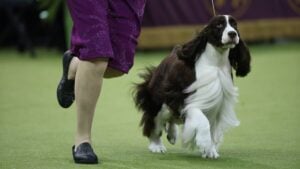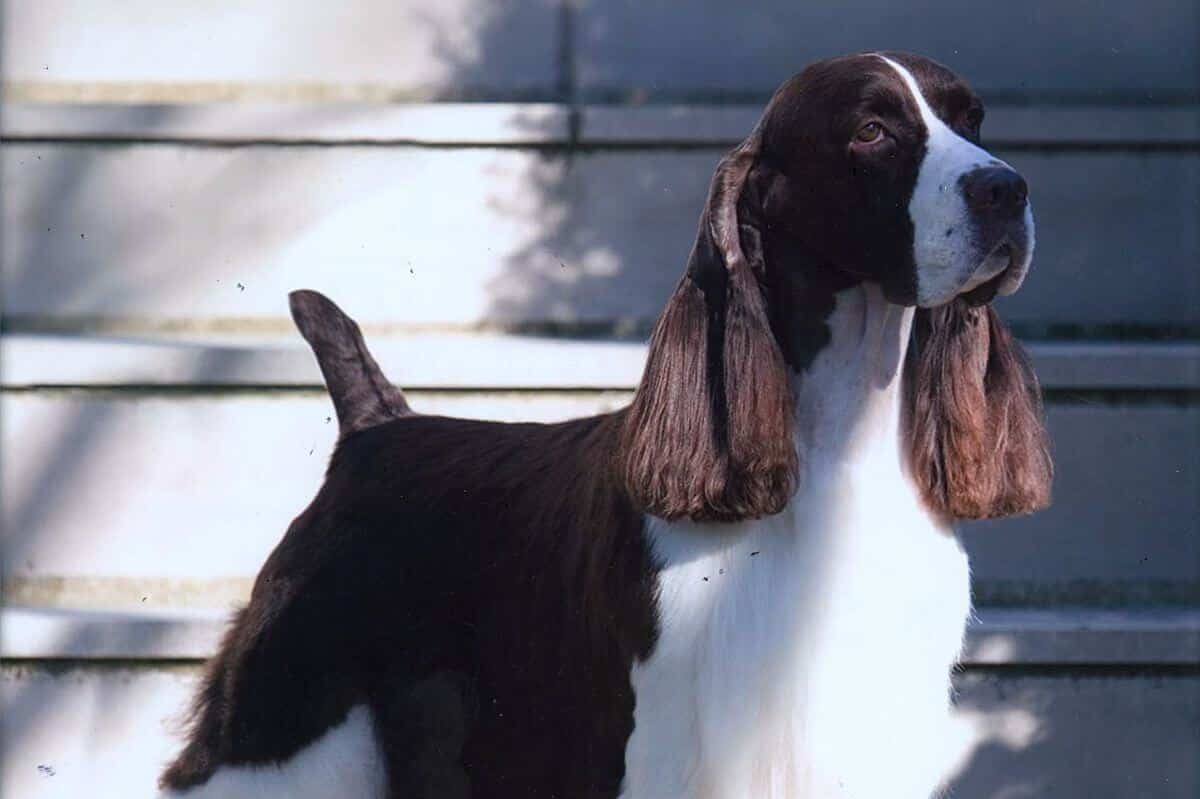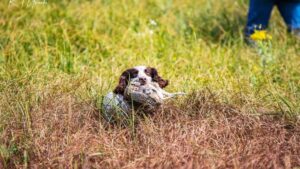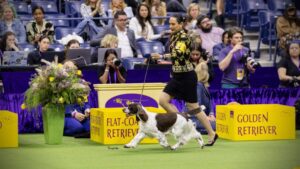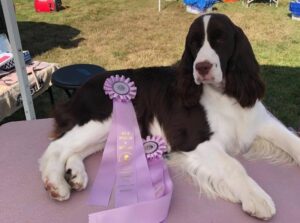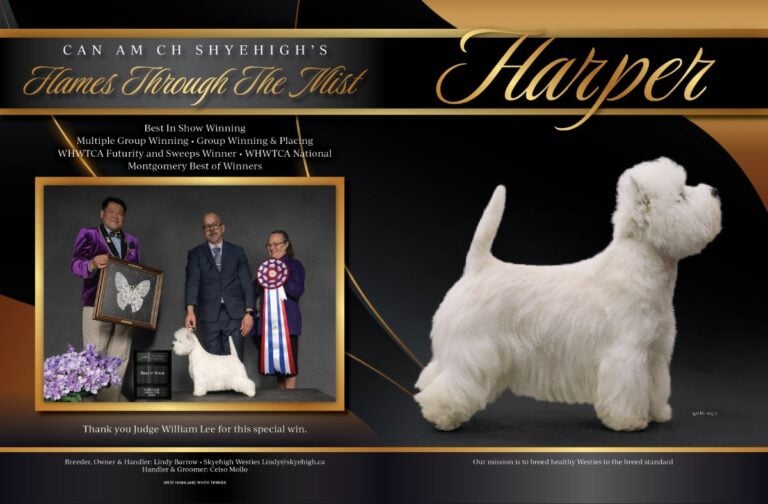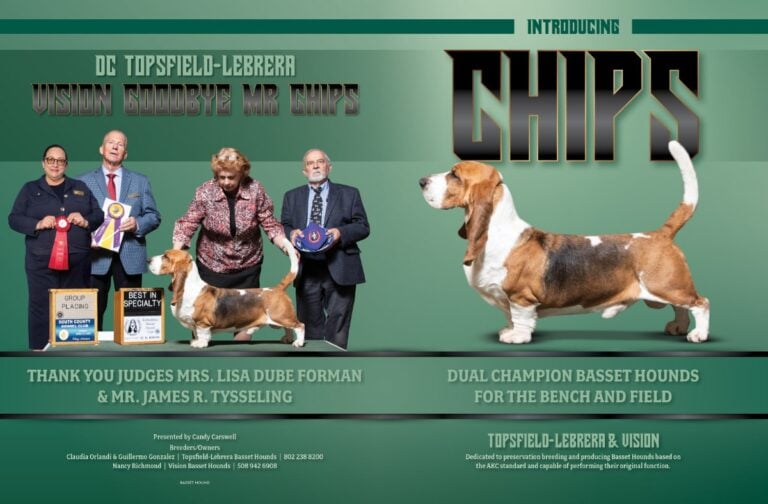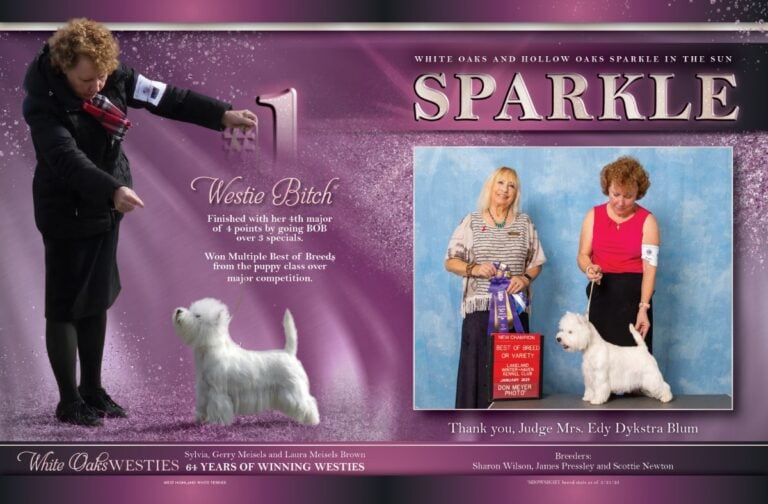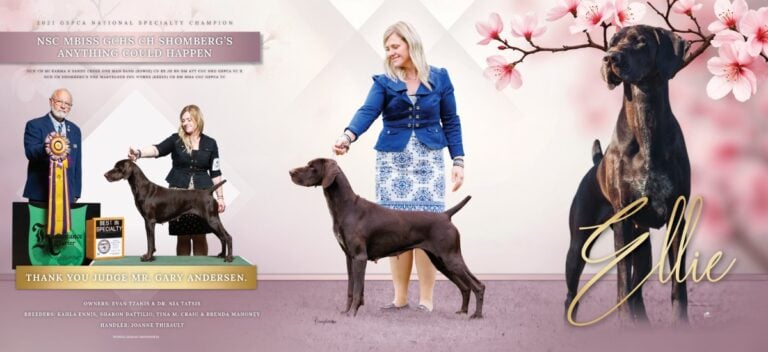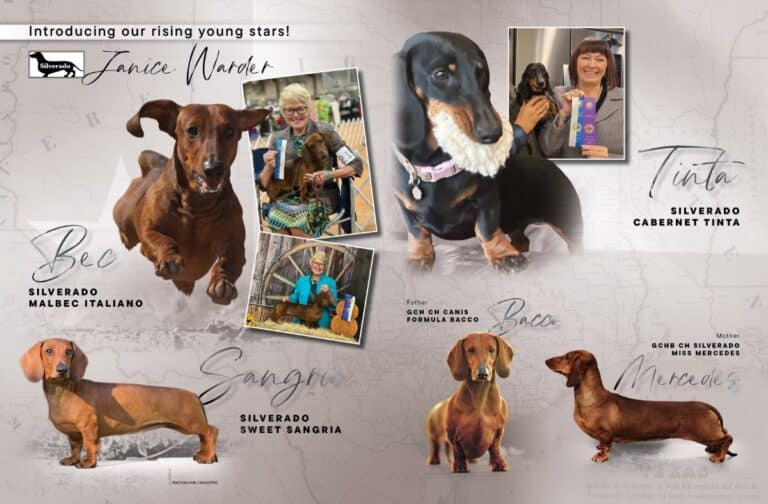History of the English Springer Spaniel
The English Springer Spaniel boasts a rich history that stretches back to the 19th century and the advent of dog shows and field trials. Known for its exceptional flushing and retrieving skills, the breed’s origins are deeply rooted in the British Isles.
The name “spaniel” is believed to have derived from the Spanish word “Espanol,” indicating that these dogs could have a Spanish connection. However, it was in England that they were refined and developed into the breeds that are recognized today. Historical records, including art and literature from the Renaissance, depict dogs that closely resemble today’s English Springer Spaniel.
During the 17th and 18th centuries, spaniels in England were primarily categorized based on their size and hunting functions. The larger ones, adept at flushing game out of dense vegetation, were termed “springers” because of their ability to “spring” game for the falcon or nets. As individual breeds began to emerge, selective breeding started to focus on specific traits, leading to the distinction between the English Springer Spaniel and its close cousins, the Field Spaniels and Cocker Spaniels.
The late 19th and early 20th centuries marked significant milestones for the Springer. In 1902, The Royal Kennel Club in the UK distinguished it as a separate breed. Recognition soon crossed the Atlantic, with the American Kennel Club (AKC) officially acknowledging the breed in 1910.
Through subsequent years, in both the field and in the show ring, the Springer has garnered considerable acclaim. The breeds’ versatility and endearing temperament have solidified its reputation as both a exceptional gun dogs and an extraordinary show dog.
Today, the English Springer Spaniel enjoys widespread admiration, reflecting its innate abilities and its outgoing disposition. Whether in a show ring, a suburban backyard, or a country estate, the breed’s legacy lives on.
General Appearance
Height & Weight
Adult male English Springer Spaniels ideally stand 20 inches tall at the shoulder, while mature females tend to be slightly smaller, measuring around 19 inches in height.
In terms of weight, males average about 50 pounds, with females weighing closer to 40 pounds.
Proportion & Substance
The English Springer Spaniel presents a balanced and useful form. Medium-sized and sturdy, this breed is robust without appearing bulky. In profile, the Springer’s back is level from the withers to a slightly sloping croup. The body, when measured from the shoulder to the buttocks, is a bit longer than the dog’s height at the withers. This proportionality ensures the breed’s agility and fluid movement, reflective of its working origins as a top-flight bird dog.
Coat Texture, Colors & Markings
Texture: The English Springer Spaniel boasts a double coat that provides insulation and protection on land and in water. It is medium in length, flat or wavy, and lies close to the body. Its texture is neither too coarse nor too silky. The hair is short and fine on the head, on the front of the forelegs, and on the front of the rear legs below the hocks. The ears, chest, belly, and legs are feathered with longer fringe. The coat is typically trimmed, but it should not be excessively stylized.
English Springer Spaniel Colors
|
Standard Color |
| Black & White |
ee |
| Black White & Tan |
ee |
| Liver & White |
ee |
| Liver White & Tan |
ee |
| White & Liver |
ee |
| White & Black |
ee |
| Red & White |
ee |
| Orange & White |
ee |
| Lemon & White |
ee |
English Springer Spaniel Markings
|
Standard Marking |
| Ticked |
ee |
| Spotted |
ee |
| Roan |
ee |
A Note About Color: Color may be black or liver with white markings; white with black or liver markings; blue or liver roan; or tricolor (black and white or liver and white with tan markings on the eyebrows and cheeks, inside the ears, and under the tail). Any areas of white may present ticking or spots. Red, Orange, and lemon are not acceptable colors in this spaniel breed.
Head
- Skull: The skull of the English Springer Spaniel is of medium length and slightly rounded, neither too broad nor too narrow. It is well-proportioned, showing a gentle descent towards the eyes.
- Expression: The expression is one of kindness and alertness. The eyes portray intelligence and an eager-to-please demeanor, indicative of the dog’s loyal nature.
- Eyes: Of medium size, the eyes are almond-shaped and usually come in shades of hazel or brown, complementing the coat’s color. They’re set well apart, with expressive eyebrows, giving a gentle yet observant expression.
- Ears: Set at eye level, the ears are moderately long and fairly wide, hanging close to the cheeks. They’re adorned with feathering that adds a touch of elegance to the head.
- Muzzle: The muzzle is strong and of good depth, with chiseling around the eyes and a well-defined stop. It’s neither snipey nor square, and is in proportion to the head.
- Nose: The nose color matches the predominant color of the dog’s coat; either black or liver. The nostrils are well-defined and open, allowing for efficient scenting ability – a nod to the breed’s hunting heritage.
- Bite: The English Springer Spaniel possesses a scissors bite, where the upper incisors neatly overlap the lower incisors. Wry bites, and undershot or overshot bites, are unacceptable.
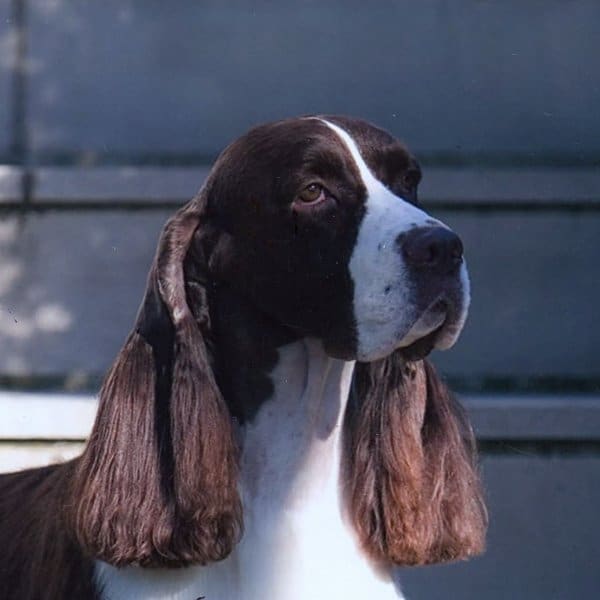
Tail
The tail of the English Springer Spaniel is an embodiment of the breed’s lively spirit and eager character. It is set as an extension of the topline and is typically docked to prevent injury while working in thick brush. When the Springer is in motion, especially when working, the tail is carried horizontally, wagging rhythmically with each stride. The tail should not be carried upright or curled forwards, nor should it be clamped down tightly.
Contemporary views on tail docking vary, so it’s essential for owners of this breed to be aware of local regulations regarding the practice.
Whether docked or undocked, the Springer’s tail always exhibits the breed’s characteristic enthusiasm and exuberance, especially when these sporting spaniels are on the move or particularly excited.
The English Springer Spaniel – What to Consider?
Owning an English Springer Spaniel can be a delightful experience. Renowned for its cheerful disposition and boundless energy, these dogs bring joy to any household and easily fit it in as loyal companions. However, as with any dog, potential owners should be well-informed about the breed’s characteristics, needs, and potential challenges.
Interaction With Family
The level of affection a breed typically shows towards family members and familiar individuals will vary. While some breeds may only show genuine warmth towards their owner, remaining standoffish with strangers, other breeds will treat everyone they meet as if they are their closest friend.
Independent Affectionate
Good With Other Dogs
The innate friendliness of a dog towards other dogs can depend on its breed. Although supervision is always recommended during introductions, certain breeds tend to be inherently more or less sociable with other dogs, whether in a home setting or in public spaces.
Not Recommended Reliable With Other Dogs
Good With Young Children
The degree to which a breed will typically be patient with young children, and its overall suitability as a family member, will vary. It is important to always supervise interactions between dogs and the kids in the house, as well as with children who are not accustomed to being around dogs.
Not Recommended Dependable With Children
Amount Of Shedding
The amount of hair that a dog sheds will typically depend on its breed. Heavy-shedding breeds require more frequent brushing, have a higher chance of activating specific allergies, and often necessitate more frequent use of the vacuum cleaner and lint rollers.
Low High
Frequency Of Grooming
The regularity with which a breed needs bathing, brushing, trimming, or other forms of coat care is an all-important consideration. When evaluating the grooming effort required, consider your available time, patience, and budget. It is important to note that all breeds need routine ear, teeth, and nail care.
Monthly Daily
Amount Of Drooling
The tendency of a breed to drool significantly varies from breed to breed. For those who prefer cleanliness or are particular about keeping things tidy, breeds that are likely to leave trails of drool on your arm or large slobbery marks on your clothing and furniture might not be the best fit.
Low High
Coat Type
smooth
wiry
hairless
rough
corded
double
curly
wavy
sikly
Acceptance Of New People
The likelihood of a breed to be friendly towards strangers will vary. While some breeds may consistently exhibit reserve or caution around unfamiliar people, regardless of the setting, others are often eager to greet and interact with any new person they meet.
Reserved Outgoing
Protective Nature
The propensity of a dog to notify you of the presence of strangers is breed-dependent. Some breeds are more inclined to respond to any perceived threat, be it the mailman or a squirrel outside the window. However, most breeds are generally more accepting of strangers who are welcomed by their human family members.
Minimal Interest Maximum Vigilance
Playfulness Level
The likelihood of a breed remaining playful beyond puppyhood will vary. Certain breeds retain their enthusiasm for activities like tug-of-war or games of fetch well into their adult years, whereas others are more content to simply lounge on the sofa with you for the majority of time.
Low High
Adaptability Level
The ease with which a breed can adapt to changes in its environment can vary greatly. This adaptability encompasses how well a breed is likely to cope with alterations to its home and yard, noise levels, weather conditions, daily routines, and other fluctuations in everyday life.
Low High
Trainability Level
The ease with which a dog can be trained and its eagerness to learn new skills can depend on the breed. Some breeds are naturally inclined to please their owners and will readily accept training, while others tend to follow their own desires, often showing independence in how, when, and where they choose to do things.
Stubborn Eager
Barking Level
The frequency of vocalization, including barking and howling, will vary from breed to breed. Some may bark at each person who passes by and every bird in the sky, while others will typically bark only for a good reason. Additionally, a few breeds that do not typically bark will still be vocal, using different sounds to communicate.
Quiet Vocal
Energy Level
The level of physical exercise and mental engagement required will depend on the breed. High-energy breeds are always on the go. They are enthusiastic about their next activity and tend to be busy most of the time, running, jumping, and playing throughout the day. In contrast, low-energy breeds are akin to couch potatoes, content to just lounge around and take naps throughout the day.
Couch Potato Busybody
Need For Mental Stimulation
The extent of mental stimulation needed to keep a dog content and healthy will vary by breed. Dogs bred for specific purposes may need tasks involving decision-making, problem-solving, and concentration. Without sufficient mental exercise, these dogs can resort to creating their own activities to engage their minds, resulting in unwanted behaviors like chewing, digging, and escaping.
Minimal Engagement Intensive Interaction
English Springer Spaniel Health
The English Springer Spaniel, when well cared for, is generally a healthy and robust breed. However, like all breeds and mixed breeds, they can be prone to certain health conditions. It is crucial for owners to be proactive in their pet’s health, maintaining a regular veterinary schedule and being observant of any behavioral or physical changes.
Lifespan: On average, a well-cared-for Springer can live between 12 and 14 years, although many have been known to surpass this with proper care, lots of love, and a bit of luck.
Potential Health Risks
The English Springer Spaniel, like any dog, can have its share of health concerns. These include:
- Hip Dysplasia: This is a genetic condition where the thigh bone doesn’t fit snugly into the hip joint. The condition can lead to arthritis or even lameness in severe cases.
- Progressive Retinal Atrophy (PRA): An eye disorder, this disease can eventually cause blindness due to the loss of photoreceptors at the back of the eye. PRA can be detected early through regular eye exams.
- Entropion: This is a condition where the eyelid rolls inward, which can irritate or injure the eyeball. Surgical intervention might be needed in some cases.
- Springer Rage: Also known as Rage Syndrome, this is a rare inheritable disorder characterized by explosive and unprovoked aggression. It is thought to be a seizure disorder.
- Otitis Externa: Given the breed’s hanging ears, Springers are susceptible to ear infections. Regular cleaning can help to prevent chronic problems.
- Skin Allergies: Springers can sometimes develop allergies to certain types of food or environmental factors. Regular grooming, and a keen observation for signs like itching or redness, can help to identify allergies early on.
It is essential for English Springer Spaniel owners to have regular veterinary check-ups, ideally twice a year. These routine visits allow early detection of potential issues, ensuring timely treatment.
English Springer Spaniel Personality
The English Springer Spaniel boasts a temperament that’s often described as affable and eager to please. The breed’s cheerful disposition allows these dogs to form strong bonds with their families and thrive on human interaction. These traits make them a suitable choice for first-time dog owners, as they’re accommodating and tend to respond positively to gentle guidance and training. Their sensitivity means they resonate best with positive reinforcement training methods; harsh treatment or scolding can potentially lead them to become timid and mistrustful.
Although they cherish their independence to a certain degree, Springers are not fans of solitude. Extended periods of being alone can trigger feelings of separation anxiety. As such, potential owners should be prepared to offer them consistent companionship or at least ensure they aren’t left isolated for long durations.
Socially, they typically get along splendidly with their canine counterparts. With proper socialization from a young age, most Springers become quite overjoyed around other dogs. Their gentle and playful demeanor also makes them ideal companions for children. However, as with any breed, interactions between dogs and young kids should always be supervised to guarantee the safety of both parties.
The English Springer Spaniel’s warm nature usually extends to strangers as well. While these dogs might approach unfamiliar faces with a hint of caution initially, with proper introductions, they’re often welcoming and friendly to the people they meet. In essence, the Springer, with its delightful personality and adaptable nature, can integrate smoothly into a variety of households, offering affection and joy in abundance.
English Springer Spaniel Feeding & Nutrition
The dietary needs and nutritional habits of the English Springer Spaniel play a pivotal role in ensuring the dog’s well-being and vitality. These dynamic canines require a balanced diet that complements their energy levels and supports their overall health.
For Springer Spaniel puppies, it’s essential to provide them with a high-quality puppy formula that meets the unique nutritional requirements of their growth phase. Puppies can grow rapidly, so their diet should account for their developing muscles, bones, and overall health. The portion size and feeding frequency can vary based on age, but generally, puppies are fed more often than adults to support their growth — typically three to four times a day.
Transitioning into adulthood, the nutritional needs of the Springer will change. Adult dogs require a balanced diet that offers a mix of proteins, fats, and essential vitamins and minerals. Proteins help to maintain muscle tone, while fats provide the necessary energy. The amount of food required can vary based on the dog’s activity level, age, and overall health. On average, an adult Springer Spaniel might consume between 1.5 to 2.5 cups of high-quality dog food daily, split into two meals. However, always consult a veterinarian or a pet nutritionist to determine the exact portion size suitable for the specific dog.
Overfeeding or underfeeding can have adverse effects on the health and longevity of an English Springer Spaniel. Monitoring their weight, ensuring they have a consistent feeding schedule, and adjusting portion sizes based on activity levels can contribute to the dog’s overall health and happiness.
English Springer Spaniel Training
English Springer Spaniels are renowned for their intelligence and willingness to please, traits that make them relatively straightforward to train. Their history as hunting dogs means they’re hardwired to respond well to tasks and commands, although their gentle nature means positive reinforcement methods work best.
Training should begin early, ideally during puppyhood. Socialization is a crucial component of any puppy’s training regime. Exposing Springer pups to various environments, people, and other animals helps to foster well-adjusted adult dogs that are comfortable in diverse settings. While they are generally eager to please their owners, it’s essential to maintain consistency in training sessions to reinforce learned behaviors and to prevent the development of unwanted habits.
Given the Springer’s intelligence, the breed has a moderate tendency to bark, especially if the dog senses something amiss or if it gets bored. Regular training and mental stimulation can help to manage this trait. The curious nature of this breed, paired with its bird dog background, means these dogs might occasionally exhibit a potential for wanderlust. It’s wise to be sure they’re always in a secure area or on a leash during outdoor excursions.
Predatory instincts aren’t particularly high in the English Springer Spaniel compared to some other breeds, but these dogs still possess a natural urge to chase. Regular recall training can be beneficial in managing this instinct, especially in environments where the Springer might encounter wildlife or other distractions.
English Springer Spaniel Exercise
An active and spirited breed, the English Springer Spaniel thrives on regular exercise and activity. Born from a lineage of field dogs, the breed’s innate drive and energy necessitate daily physical stimulation to keep these dogs content and in optimal health.
Exercise Expectations
| Energy Level |
High |
| Exercise Requirements |
2 Hours/Day, Daily Walks, Vigorous Running, Regular Exercise, Playing with Another Dog, Mental Stimulation |
While they might adjust to shorter walks on occasion, Springer Spaniels generally benefit from long walks, off-leash playtime in secure areas, and interactive games like fetch. Their agility and energetic movements make them great companions for more rigorous activities like hiking or jogging, always taking care to ensure it’s a safe environment for the dog.
The Springer’s energy levels are often described as above average, which means this breed isn’t the type to lounge around all day. Without adequate exercise, these dogs might resort to unwanted behaviors out of boredom or pent-up energy. It’s not just physical exercise that these spaniels crave; their sharp minds need stimulation too. Integrating puzzle toys, obedience training, or even agility courses can be an excellent way to engage both their bodies and minds.
Yet, despite their energetic nature, Springer Spaniels are equally content spending downtime with their families. After a day of play and activity, they’ll relish the opportunity to relax by their favorite person’s side, proving once again their adaptability and desire for companionship.
In terms of playfulness, English Springer Spaniels are known to retain a puppy-like enthusiasm well into their adult years. Their spirited and fun-loving nature makes them delightful playmates, whether it’s with humans or other dogs. However, it’s always necessary to be certain that their exercise regimen aligns with their age, health, and individual needs.
English Springer Spaniel Grooming
The English Springer Spaniel’s coat is not just a testament to its beauty but also a reflection of its working nature. While this breed doesn’t shed excessively, it does undergo seasonal shedding, and thus, a consistent grooming routine is crucial to keep its coat healthy and looking its best.
Grooming Expectations
| Coat Type |
Close, Straight, Weather-Resistant, Feathered
|
| Grooming Requirements |
Daily Combing, Weekly Brushing, Occasional Bathing, Routine Ear Cleaning, Periodic Nail Trimming, Regular Tooth Brushing |
The coat is medium in length and may have a slight wave, making it prone to tangling and matting if not maintained. Regular brushing, at least two to three times a week, can help to prevent these issues and reduce the amount of hair that’s shed around the house. A pin brush or slicker brush is often ideal for detangling and removing loose hair.
In addition to brushing, occasional trims are necessary, especially around the ears, paws, and hindquarters. This not only accentuates the dog’s natural shape but also reduces the chance of burrs or other debris getting caught in their feathering during outdoor excursions.
The Springer’s ears, being floppy and covered in hair, can trap moisture, making them susceptible to infections. It’s vital to check and clean the ears weekly, ensuring they’re dry and free from debris. Use a veterinarian-recommended ear cleaning solution and a cotton ball for this purpose.
Like all breeds, Springer Spaniel’s benefit from regular dental care. Brushing the teeth a few times a week, if not daily, can help to prevent tartar buildup and gum disease. Nails should be trimmed periodically, or as needed, to prevent overgrowth and the complications that can arise from it.
While English Springer Spaniels aren’t necessarily high maintenance in terms of grooming, they do require consistent care. A well-groomed spaniel not only looks stunning, it also stays healthier and is more comfortable in any environment. Regular grooming sessions also offer a wonderful bonding opportunity between the dog and the groomer.
Living with an English Springer Spaniel
Living with an English Springer Spaniel is a delightful experience marked by affection, energy, and loyalty. The breed’s versatile nature means these dogs can adapt to various living situations, but there are certain aspects to consider that will support a comfortable and fulfilling life.
In terms of housing, while they are adaptable to apartment living, Springer Spaniels thrive best in homes with a yard or access to open spaces. Their inherent energy levels require space to roam, play, and exercise. However, if residing in an apartment, it becomes even more vital to provide them with regular outdoor activities and daily walks to compensate for the limited space.
Climate considerations are also essential. Springers have a medium-length coat that provides them with some protection against the cold. They can tolerate cold weather reasonably well, but it’s always wise to monitor them during extreme weather conditions, ensuring they aren’t exposed for extended periods. Their coat also offers some protection in warmer climates, but like all dogs, they can be susceptible to overheating. In hot weather, it’s crucial to provide plenty of water and shade, and limit their exposure during peak heat hours.
The breed is known for its sociable nature, meaning Springer Spaniels cherish time spent with their families. Extended periods of isolation or loneliness can lead to anxiety or undesirable behaviors. They fare best in environments where they have consistent interaction, be it with humans or other pets.
The English Springer Spaniel’s intelligence and curiosity might sometimes lead them to explore, so it’s essential to have a secure fence or boundary if they’re playing outside unsupervised. This all but guarantees they don’t wander off or chase after potential distractions.
English Springer Spaniel Puppies
The arrival of English Springer Spaniel puppies is an event filled with excitement and anticipation. These little bundles of joy, with their boundless energy and heart-melting expressions, are sure to bring delight to any household. However, it’s essential to remember that puppies are in their formative stages, and the environment and care they receive now will significantly influence their temperament and health as adults.
Caring for an English Springer Spaniel Puppy
Raising an English Springer Spaniel puppy is both a privilege and a responsibility. During their first few weeks, these puppies require a lot of care, attention, and patience.
Diet is of paramount importance. Puppies have specific nutritional needs to support their growth and development, so it’s crucial to feed them high-quality puppy food that meets all their dietary requirements. Consultation with a vet or breeder can provide guidance on the best brands and feeding schedules.
Socialization during the early stages is also vital. Introducing puppies to various people, pets, sounds, and environments can significantly influence their temperament as adults. Positive encounters during this phase can result in well-adjusted, confident adult dogs. However, remember that until puppies have their full set of vaccinations, it’s essential to be cautious about where they’re taken and which animals they interact with.
Training should begin early, using positive reinforcement techniques. Springer Spaniels are eager to please and respond well to consistent and gentle guidance. Housetraining, basic commands, and crate training can start in the puppy stage, laying the foundation for good behavior in the future.
Regular vet check-ups during the Springer’s first year are crucial to monitor the puppy’s growth and to be sure it receives all the necessary vaccinations and treatments. This preventative care can help to identify and address potential health issues before they become severe.
Lastly, playtime and affection play a pivotal role in the life of an English Springer Spaniel puppy. These moments and interactions not only strengthen the bond between puppy and owner, they also contribute to everyone’s overall well-being and happiness.
Frequently Asked Questions (FAQ)
Do English Springer Spaniels shed?
Yes, English Springer Spaniels shed. They have a double coat, with a soft, insulating undercoat and a longer outer coat. Regular grooming, including combing and brushing several times a week, can help to manage and reduce the amount of loose hair.
How long do English Springer Spaniels live?
Springers typically have a lifespan of 12 to 14 years. Like all dogs, their longevity can be influenced by genetics, diet, exercise, and regular veterinary care. Proper attention to their health and well-being can ensure they live a long, fulfilling life.
Are English Springer Spaniels hypoallergenic?
No, Springer Spaniels are not considered hypoallergenic. They shed and they produce dander, which can trigger allergies in sensitive individuals. To gauge a person’s possible reaction, those with allergies should spend time around the breed before deciding to bring one home.
How big do English Springer Spaniels get?
English Springer Spaniels are medium-sized dogs. Males typically stand around 20 inches at the shoulder, while females measure around 19 inches. In terms of weight, males generally hover around 50 pounds, with females weighing closer to 40 pounds.
Are English Springer Spaniels aggressive?
By nature, English Springer Spaniels are not aggressive; they are known for their friendly and outgoing temperament. However, like any breed, individual behavior can vary based on upbringing, socialization, training, and unfortunately, disease. It’s essential to provide all Springers with proper training and socialization from a young age.
Are English Springer Spaniels good apartment dogs?
While Springer Spaniels can adapt to apartment living, they are energetic and active dogs that require regular exercise. If their exercise needs are met with daily walks and play sessions, they can thrive in an apartment setting, but a larger living space with a yard is often ideal.
Are English Springer Spaniels good hunting dogs?
Absolutely, English Springer Spaniels excel as hunting dogs. Historically bred to “spring” or flush game from hiding places, these dogs have keen noses and are highly trainable, making them adept at tracking, flushing, and retrieving in hunting scenarios.
Are English Springer Spaniels good with cats?
Generally, English Springer Spaniels can get along well with cats, especially if they are introduced to them at a young age. As with any breed, early socialization is crucial. However, individual dogs might have different prey drives, so it’s always best to supervise initial interactions between a Springer and a cat.
